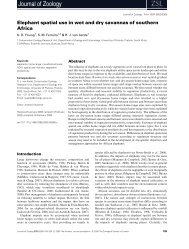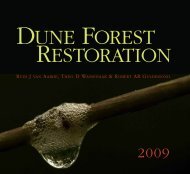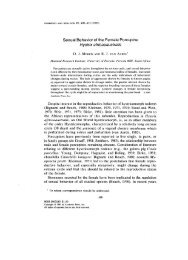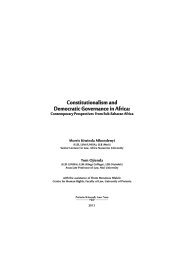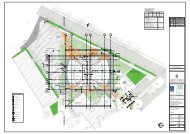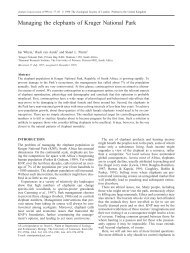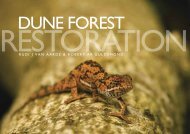Neighbourhood renewal in Cape Town's inner city: Is it gentrification?
Neighbourhood renewal in Cape Town's inner city: Is it gentrification?
Neighbourhood renewal in Cape Town's inner city: Is it gentrification?
You also want an ePaper? Increase the reach of your titles
YUMPU automatically turns print PDFs into web optimized ePapers that Google loves.
ISSN 0378-5254 Tydskrif vir Ges<strong>in</strong>sekologie en Verbruikerswetenskappe, Vol 28, 2000<br />
TABLE 1: POTENTIAL GENTRIFICATION AREAS (1995)<br />
<strong>Neighbourhood</strong>s Distance from Age of neigh- % of medium- % of owner % of properties<br />
the CBD bourhood dens<strong>it</strong>y hous<strong>in</strong>g occupiers renovated<br />
Bo-Kaap 0,9 124 years 87,8 68,4 34,2<br />
De Waterkant 1 112 years 88 44,4 76,5<br />
Lower Gardens 1 110 years 73,8 47,1 77,8<br />
Woodstock 2,6 90 years 76,8 67,0 31,9<br />
Salt River 3,2 83 years 68,3 68,4 21,1<br />
Walmer Estate 2,7 69 years 45 72,0 34,6<br />
TABLE 2: DISCRIMINANT AND CLASSIFICATION FUNCTIONS OBTAINED AFTER STEPWISE<br />
DISCRIMINANT ANALYSIS<br />
beautify<strong>in</strong>g (plant<strong>in</strong>g trees, develop<strong>in</strong>g park<strong>in</strong>g areas)<br />
the neighbourhood at the time of the study (1995)<br />
When the hous<strong>in</strong>g un<strong>it</strong>s <strong>in</strong> the six neighbourhoods were<br />
scrut<strong>in</strong>ised, <strong>it</strong> was evident that a large percentage had<br />
the same basic floor plan, although they were built <strong>in</strong><br />
different eras result<strong>in</strong>g <strong>in</strong> different façades (see Figure<br />
2). The diagram represents no specific hous<strong>in</strong>g un<strong>it</strong><br />
found <strong>in</strong> these areas and is a schematic representation<br />
of the floor plans to be found <strong>in</strong> these neighbourhoods<br />
as observed dur<strong>in</strong>g the gather<strong>in</strong>g of data. The bathroom<br />
at the back of the hous<strong>in</strong>g un<strong>it</strong> was a later add<strong>it</strong>ion<br />
to these properties. The reason for this type of floor<br />
plan must have been a shortage of land close to the<br />
CBD, w<strong>it</strong>h the result that row houses were developed<br />
for the work<strong>in</strong>g class <strong>in</strong> these <strong>in</strong>ner-<strong>c<strong>it</strong>y</strong> neighbourhoods<br />
of <strong>Cape</strong> Town.<br />
42<br />
Variables Function coefficients<br />
Canonical Discrim<strong>in</strong>ant<br />
(standardise)<br />
Classification<br />
Restorers Non-restorers<br />
Occupation 0,7016 0,9004 1,7663<br />
Family size 0,4989 0,5112 1,0775<br />
Cond<strong>it</strong>ion of property <strong>in</strong> the past -0,4899 4,3414 3,0834<br />
Qualifications -0,3187 4,9516 4,3930<br />
Cond<strong>it</strong>ion of property at present 0,2845 1,4776 2,4139<br />
Purchas<strong>in</strong>g of clothes -0,1738 6,9169 6,3066<br />
Ownership 0,1693 0,9563 1,3172<br />
Contact w<strong>it</strong>h colleagues -0,1355 19,6720 18,9109<br />
Number of bedrooms 0,1248 2,4121 2,6908<br />
Income 0,1020 2,6254 2,8053<br />
Contact w<strong>it</strong>h neighbours -0,0916 2,2794 2,0662<br />
Gender<br />
Mar<strong>it</strong>al status<br />
Language<br />
Age of respondents<br />
Type of hous<strong>in</strong>g un<strong>it</strong><br />
Number of rooms<br />
Church attendance<br />
Sport participation<br />
Purchas<strong>in</strong>g of groceries<br />
Location of bank<br />
No important dist<strong>in</strong>guish<strong>in</strong>g variables<br />
From the <strong>in</strong><strong>it</strong>ial <strong>in</strong>vestigation of the data collected dur<strong>in</strong>g<br />
the systematic sample survey, <strong>in</strong> which the different variables<br />
were considered separately, there were <strong>in</strong>dications<br />
that the urban <strong>renewal</strong> process evident <strong>in</strong> some of<br />
the neighbourhoods corresponded more closely to <strong>in</strong>ternational<br />
f<strong>in</strong>d<strong>in</strong>gs on <strong>gentrification</strong> than <strong>in</strong> other areas.<br />
Discrim<strong>in</strong>ant analysis<br />
To test whether the urban <strong>renewal</strong> that was evident <strong>in</strong><br />
the six residential areas (De Waterkant, Bo-Kaap, Lower<br />
Gardens, Woodstock, Salt River and Walmer Estate)<br />
was <strong>in</strong> fact <strong>gentrification</strong>, a discrim<strong>in</strong>ant analysis procedure<br />
was undertaken. This is a multivariate statistical<br />
technique that is used to dist<strong>in</strong>guish between two or<br />
more oppos<strong>in</strong>g groups w<strong>it</strong>h the aid of a number of relevant<br />
variables (Klecka, 1980:7). In this case study <strong>it</strong> was<br />
<strong>Neighbourhood</strong> <strong>renewal</strong> <strong>in</strong> <strong>Cape</strong> Town’s <strong>in</strong>ner <strong>c<strong>it</strong>y</strong>: is <strong>it</strong> <strong>gentrification</strong>?






